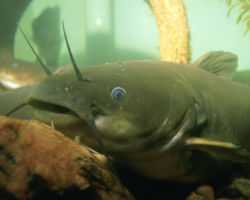Yellow bullhead
| Yellow bullhead | |
|---|---|
 | |
| Conservation status | |
| Not evaluated (IUCN 3.1) | |
| Scientific classification | |
| Kingdom: | Animalia |
| Phylum: | Chordata |
| Class: | Actinopterygii |
| Order: | Siluriformes |
| Family: | Ictaluridae |
| Genus: | Ameiurus |
| Species: | A. natalis |
| Binomial name | |
| Ameiurus natalis (Lesueur, 1819) | |
Description
The yellow bullhead, (Ameiurus natalis) is a species of bullhead catfish that is a ray-finned fish that lacks scales. This particular species is a medium sized member of the catfish family. It is typically yellow-olive to slatey-black on the back and sometimes mottled depending on habitat. The sides are lighter and more yellowish, while the underside of the head and body are bright yellow, yellow white, or bright white. The rear edge of its caudal fin is rounded. The anal fin is much larger than many fish having anywhere between 23 and 27 rays. The yellow bullhead though less common, can be easily distinguished from the brown bullhead and black bullhead by its white barbels or "whiskers". Yellow bullheads are medium-sized bullheads rarely getting larger than 2 lb (0.91 kg) but can reach up to 3.5 pounds. Yellow bullheads range in size from 6-15 inches but can reach up to 18 inches and live up to 7 years. There have been studies that have found yellow bullheads ranging from 1 to 12 years of age, the study used over 200 fish from different habitats in the southern Florida everglades to conduct this experiment.1 In the study they used the total length of a bullhead as a function of absolute age allowing them to compare the pectoral spine length and weight.1 Catfish and bullheads have sub-terminal mouths in which the end of the snout only projects slightly beyond the mouth of the fish.
Diet
The yellow bullhead is a voracious scavenger that will almost eat anything. It locates prey by brushing the stream bottom with its barbels. Taste buds on the barbels tell the bullhead whether or not contact is made with edible prey. They typically feed at night on a variety of plant and animal material, both live and dead, most commonly consisting of insects, snails, minnows, clams, crayfish, other small aquatic organisms, and decaying animal matter.
Habitat
Yellow bullhead are bottom dwellers, living in areas with muck, rock, sand, or clay substrates. Its habitat includes river pools, backwaters, and sluggish current over soft or mildly rocky substrate in creeks, small to larger rivers, and shallow portions of lakes and ponds. Their habitat can vary from a slow current with poorly oxygenated, highly silted, and highly polluted water to a more swift current with clean and clear water that has aquatic vegetation. Fishermen often find them in sluggish creeks and rivers with a gravel bottom.
Reproduction and Life Cycle
Bullheads have a monogamous relationship with spawning beginning in mid-May or early-June, with both sexes participating in nest-building. Bullheads usually use a natural cavities or make saucer shaped depressions near submerged cover, such as a trees roots or a sunken log. The female will lay anywhere from 300 to 7,000 eggs in a gelatinous mass, and after fertilization the male protects and continually fans the nest of eggs. The eggs hatch within five to 10 days and young fry are herded into tight schools by the male and protected by both parents until they are approximately two inches long. They grow to about 3 inches by one year of age. Sexual maturity is reached between the ages of 2 and 3 years, when the fish are at least 140 mm in length.
Distribution
Yellow bullhead range throughout the central and eastern US from central Texas, north into North Dakota, and east through the Great Lakes region to the East Coast. In Minnesota, Yellow bullheads are found on the eastern and central portions of the state and are absent in the top third of the state.
Importance to Humans
Yellow bullheads are considered a minor game fish, and they are sought after for food. Yellow bullheads also can be introduced into streams with high pollution because of their high tolerance to pollution. They are not as sought after as other catfishes, but are still a game fish providing many a great fishing trip.
Etymology
Named both Ictalurus natalis and Ameiurus natalis. Ictalurus, Greek, meaning "fish cat"; Ameiurus, Greek, meaning “privative curtailed,” in reference to the caudal fin lacking a notch; natalis, Latin, meaning “having large buttocks”
See also
- Bullhead catfish (general)
References
- "Ameiurus natalis". Integrated Taxonomic Information System. Retrieved 6 June 2006.
- Froese, Rainer and Pauly, Daniel, eds. (2006). "Ameiurus natalis" in FishBase. May 2006 version.
- McClane, A.J. (1974). McClane's Field Guide to Freshwater Fishes of North America. New York: Henry Holt and Company. pp. 111–112. ISBN 0-8050-0194-8.
- "A Boundary Waters Compendium". Retrieved 2007-03-27.
- Page, Lawrence; Burr, Brooks (1991). A Field Guide to Freshwater Fishes. Boston: Houghton Mifflin Company. pp. 193–194. ISBN 0-395-91091-9.
- "Texas Parks and Wildlife". Retrieved 2007-03-14.
- "Arizona Game and Fish". Retrieved 2007-03-14.
- "Ameiurus natalis (Lesueur), Yellow bullhead - Biodiversity of Great Smoky Mountains National Park". Retrieved 2007-10-16.
- "Variable growth and longevity of yellow bullhead (Ameiurus natalis) in the Everglades of south Florida, USA". Retrieved 2013-05-03.1
External links
- Montana Fish, Wildlife and Parks Guide
- Animal Diversity Web
- Minnesota Fish, Department of Natural Resources
- Ohio Fish Department of Natural Resources